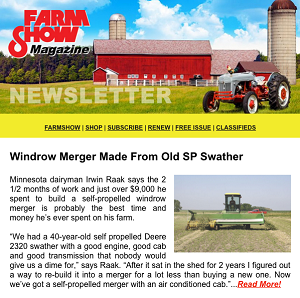They Collect Antique Washing Machines
William and Arlene Olson of Roosevelt, Minn., own quite a unique collection of antique washing machines. They enjoy not only displaying the machines but also operating them at the annual Lake of the Woods Steam and Gas Show held in Minnesota the first weekend every August.
Arlene started the collection more than 20 years ago when she bought a 1924 Dexter round, wooden hand-operated wringer washer.
“It was sitting there at the show, and you could see that it was slowly deteriorating,” says Arlene. “The lid was closed so the inside of the tub wasn’t showing, and no one was there to explain how it worked. It sparked my interest. I finally found the woman who owned the washer and asked if I could buy it. Her first response was ‘no’ but she did ask why, and I answered, ‘So we can fix it up and demonstrate it at this show next year’.”
The Dexter was operated by pushing a long handle back and forth to rotate a 16-in. dia. flywheel. The flywheel drove a rack and pinion gear on the tub’s lid that made a wooden agitator go back and forth.
“You could put a belt on a small pulley attached to the side of the flywheel and use a stationary or portable engine to operate the washer, which some farm wives did,” says Bill. “They would use the engine to operate the washing machine on wash days, and when they were done the farmer would get the engine back to do farm work.”
After that, Arlene started adding items each year to her collection, including washboards, a handheld vacuum plunger, and even a small “soap saver”, which is a small wire basket that you put small pieces of soap in, which were then swished through the water. “It made use of every little bit of the soap,” says Arlene.
Bill’s favorite machine is the Superior hand-operated vacuum washer. It uses a back and forth motion that agitates the water and clothes with minimal effort.
“The underside of the tub’s lid is equipped with a pair of 8-in. dia. metal cups, and the operator moved a wooden lever back and forth to pivot the cups up and down to agitate the clothes. The machine’s hand-operated wringer was then used to wring out the water,” says Bill.
Their Rocker Tub washer contains a copper tub equipped with interior baffles that rock back & forth until the clothes are clean. The clothes are then run through a powered wringer and into a pair of rinse tubs, and then hung on a line to dry.
“It was actually called the ABC Laundress Oscillator Electric Washing Machine,” says Bill. “The farmer bought the machine that we own equipped with an electric motor, before he even had electricity on the farm. He used a generator to operate the motor until electricity came to his place. He probably bought the washer in the early to mid 1940's.”
Their collection also includes a couple of belt-driven Maytag washing machines, one operated by a single cylinder gas engine and the other by a twin-cylinder.
“The single cylinder machine could also be used as a butter churn. The owner simply removed the agitator and slipped the butter churn on in its place. Or, you could remove the wringer and fit a standard meat grinder onto the wringer post. The meat grinder was shaft-driven the same way as the wringer. Maytag Gyratator Washers were made in the 1920’s and 30’s,” notes Bill.
Contact: FARM SHOW Followup, William and Arlene Olson, Roosevelt, Minn. (weolson@wiktel.com).
They Collect Antique Washing Machines William and Arlene Olson of Roosevelt Minn own quite a unique collection of antique washing machines They enjoy not only displaying the machines but also operating them at the annual Lake of the Woods Steam and Gas Show held in Minnesota the first weekend every August Arlene started the collection more than 20 years ago when she bought a 1924 Dexter round wooden hand-operated wringer washer “It was sitting there at the show and you could see that it was slowly deteriorating ” says Arlene “The lid was closed so the inside of the tub wasn’t showing and no one was there to explain how it worked It sparked my interest I finally found the woman who owned the washer and asked if I could buy it Her first response was ‘no’ but she did ask why and I answered ‘So we can fix it up and demonstrate it at this show next year’ ” The Dexter was operated by pushing a long handle back and forth to rotate a 16-in dia flywheel The flywheel drove a rack and pinion gear on the tub’s lid that made a wooden agitator go back and forth “You could put a belt on a small pulley attached to the side of the flywheel and use a stationary or portable engine to operate the washer which some farm wives did ” says Bill “They would use the engine to operate the washing machine on wash days and when they were done the farmer would get the engine back to do farm work ” After that Arlene started adding items each year to her collection including washboards a handheld vacuum plunger and even a small “soap saver” which is a small wire basket that you put small pieces of soap in which were then swished through the water “It made use of every little bit of the soap ” says Arlene Bill’s favorite machine is the Superior hand-operated vacuum washer It uses a back and forth motion that agitates the water and clothes with minimal effort “The underside of the tub’s lid is equipped with a pair of 8-in dia metal cups and the operator moved a wooden lever back and forth to pivot the cups up and down to agitate the clothes The machine’s hand-operated wringer was then used to wring out the water ” says Bill Their Rocker Tub washer contains a copper tub equipped with interior baffles that rock back & forth until the clothes are clean The clothes are then run through a powered wringer and into a pair of rinse tubs and then hung on a line to dry “It was actually called the ABC Laundress Oscillator Electric Washing Machine ” says Bill “The farmer bought the machine that we own equipped with an electric motor before he even had electricity on the farm He used a generator to operate the motor until electricity came to his place He probably bought the washer in the early to mid 1940 s ” Their collection also includes a couple of belt-driven Maytag washing machines one operated by a single cylinder gas engine and the other by a twin-cylinder “The single cylinder machine could also be used as a butter churn The owner simply removed the agitator and slipped the butter churn on in its place Or you could remove the wringer and fit a standard meat grinder onto the wringer post The meat grinder was shaft-driven the same way as the wringer Maytag Gyratator Washers were made in the 1920’s and 30’s ” notes Bill Contact: FARM SHOW Followup William and Arlene Olson Roosevelt Minn weolson@wiktel com






